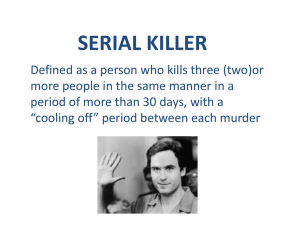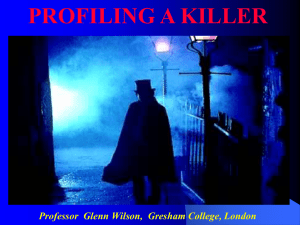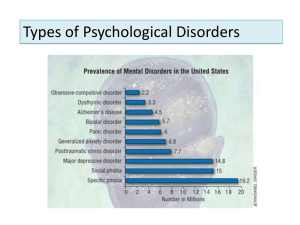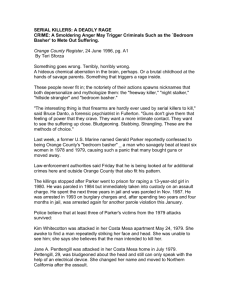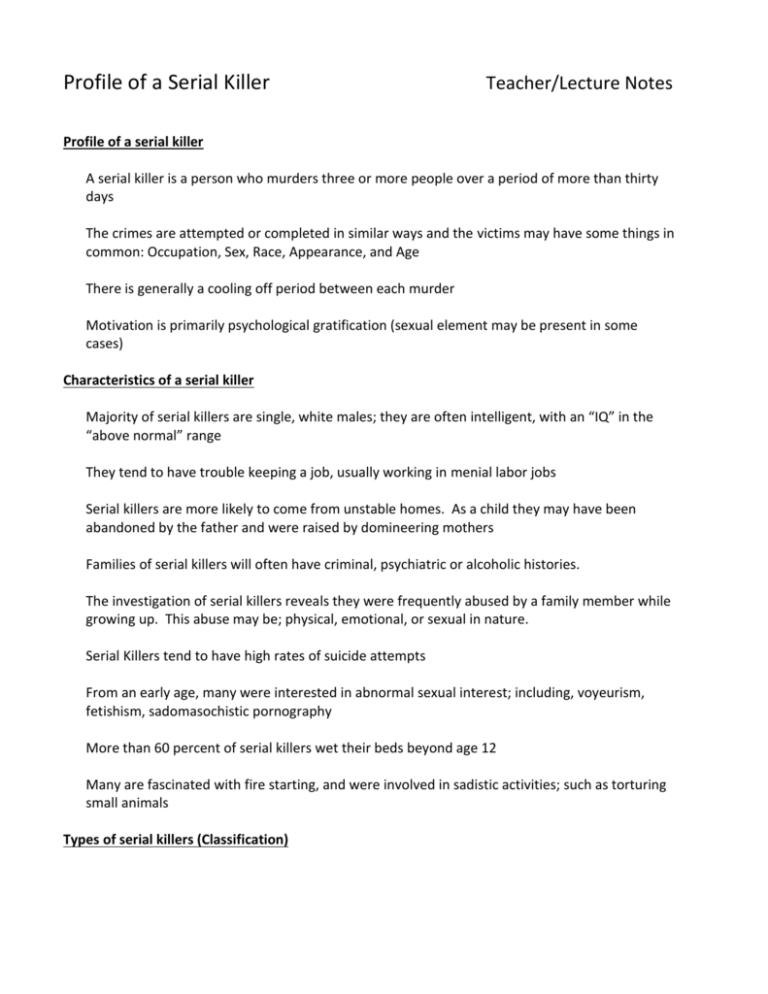
Profile of a Serial Killer
Teacher/Lecture Notes
Profile of a serial killer
A serial killer is a person who murders three or more people over a period of more than thirty
days
The crimes are attempted or completed in similar ways and the victims may have some things in
common: Occupation, Sex, Race, Appearance, and Age
There is generally a cooling off period between each murder
Motivation is primarily psychological gratification (sexual element may be present in some
cases)
Characteristics of a serial killer
Majority of serial killers are single, white males; they are often intelligent, with an “IQ” in the
“above normal” range
They tend to have trouble keeping a job, usually working in menial labor jobs
Serial killers are more likely to come from unstable homes. As a child they may have been
abandoned by the father and were raised by domineering mothers
Families of serial killers will often have criminal, psychiatric or alcoholic histories.
The investigation of serial killers reveals they were frequently abused by a family member while
growing up. This abuse may be; physical, emotional, or sexual in nature.
Serial Killers tend to have high rates of suicide attempts
From an early age, many were interested in abnormal sexual interest; including, voyeurism,
fetishism, sadomasochistic pornography
More than 60 percent of serial killers wet their beds beyond age 12
Many are fascinated with fire starting, and were involved in sadistic activities; such as torturing
small animals
Types of serial killers (Classification)
Serial killers are generally classified one of two ways; Organized/Nonsocial offenders or
Disorganized/Asocial offenders.
Organized/Nonsocial Offenders
These serial killers have an above average intelligence.
The organized offender will plan crimes methodically; victims are usually abducted from one
location, taken to another location where they are killed and then the body is disposed of in a
third location
The organized offender likes to use ploys to lure their victims. They play on the sympathy of
the victim.
Specific types of victims may be targeted by the organized offender. (i.e. prostitutes,
runaways)
This type of offender has the need to maintain a high degree of control over the crime scene.
They have knowledge of forensic science and will attempt to cover their tracks (i.e. bury
bodies (or weigh it down and sink it in water)
This offender will follow the case in the media and take pride in their actions.
Generally, the organized/nonsocial offender is socially adequate. They tend to have friends,
lovers, and family.
When captured, the organized offender may be described by people who know them as kind
or someone who is unlikely to hurt anyone
Serial Killers who may be considered Organized/Nonsocial Offenders would include:
Ted Bundy and John Wayne Gacy
Disorganized/asocial offenders
The disorganized offender is more likely have low intelligence
They commit crimes impulsively, primarily when an opportunity arises
Victims will be attacked suddenly and without warning; the offender may leap out and attack
The disorganized offender may conduct rituals after the victim is dead (necrophilia,
mutilation, and cannibalism are examples)
This offender will rarely worry about covering their tracks. They evade capture for a period of
time primarily due to the anonymity of the crime (stranger on stranger)
The disorganized offender is frequently introverted; someone who is socially inadequate with
few friends and may have a history of mental problems.
An example of serial killers who we consider to be disorganized would be: Richard Chase
Motives for serial killers
There are four primary motives for serial killers to act. They are considered…Visionary, Missionoriented, Hedonistic, or seeking Power or Control.
Visionary serial killers
Usually suffer from psychotic breaks with reality. They believe they are another person and are
compelled to murder; by God or the devil
The two most common subgroups of visionary serial killers are: Demon mandated and God
mandated
An example of the visionary serial killer is David Berkowitz (Son of Sam). He claimed demons
transmitted orders though his neighbor’s dog
Mission-oriented serial killers
This type of killer will attempt to justify their acts by saying they are ridding the world of
undesirables; including, homosexuals, prostitutes, people with different ethnicities and people
with different religions.
Mission-oriented serial killers are usually not psychotic; they see their role is to change the
nature of human society; to cure a social ill
Hedonistic serial killers
The hedonistic killers are seeking the thrills and pleasure they gain from killing.
The people are an expendable means to this goal
There are three subtypes of hedonistic killers; Lust, Thrill and Comfort
Lust Killers
Sex is the primary motive for these killers.
Their victims may be dead or alive; although fantasy plays large roll in killing
The level of sexual gratification will depend on the amount of torture and/or mutilation
involved
The lust killer will use weapons that require close contact with victim (knife or hands)
As the lust killer continues to kill, the time between murders will decrease while the
required level of stimulation increases
Thrill killers
The primary motive of the thrill killer is to produce pain or create terror, which provide
stimulation and excitement
Killers in this category seek the adrenaline rush produced by hunting and killing
They murder only for the kill; the attack is not prolonged and there is not any sexual
aspect to their crimes.
This type of killer will try to commit what they see is the perfect crime and believe they
will not be caught
Victims of thrill killers are usually strangers
Examples of thrill killers are: the Belt way snipers (Lee Boyd Malvo and John Allen
Muhammad) and the Zodiac Killer
Comfort killers
The primary motive of comfort killers is material gain and/or comfort of their lifestyle
Victims of comfort killers are frequently family members of people the killer had a close
association with.
This type of killer will have an extended time period between murders; to allow suspicion
to be focused on others, not them
The comfort killer has been known to use poisons as the weapon, with arsenic being very
common; especially if the killer is a female.
Two of the female serial killers who would be considered comfort killers are; Dorothea
Puente and H.H. Holmes
Power or control
Main objective of this type of serial killer is to gain or exert power over the victim
This offender may have been abused as a child; and left with feelings of powerlessness and
inadequacy as adults
Many of these offenders will sexually abuse their victims, motivated by dominating the victim
Signatures or souvenirs of serial killers
Certain serial killers choose to “collect” signatures or souvenirs from their victims.
These are considered behavioral characteristics or psychological markers unique to the
specific killer.
Signatures or souvenirs may include: posing the victims (post death), concealing victims,
using the same type of weapon, using the same method of killing, or mutilating all the
victims in the same manor.
Investigating a serial killer
Phases of profiling
Antecedent
What plan or fantasy, or both did the murderer have in place before the act?
What triggered the murderer to act some days and not others?
Method and Manner
What type of victim(s) did the murdered select?
What method and manner of murder?
Shooting
Stabbing
Strangulation
Other
Body Disposal
Did the murder and body disposal happen at the same scene? Or multiple scenes?
Post-offense behavior
Is the murderer trying to inject himself into the investigation?
Reacting to media reports
Contacting investigators
Unsolved Cases
There are a lot of ideas on what happens to serial killers when cases are never solved.
Experts theorize that some of these killers commit suicide or die, while others may be in jail,
mental institutions. Still others may relocate or stop killing and a few may actually turn
themselves in to authorities.
Famous Serial Killers
Ted Bundy (1974-1978)
Jeffrey Dahmer (1978-1991)
Ed Gein (1947-1957)
John Wayne Gacy (1972-1978)
David Berkowitz (1976-1977)
Aileen Wuornos (1989-1990)


